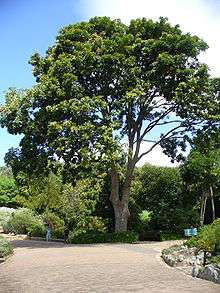Khaya anthotheca
| Khaya anthotheca East African mahogany | |
|---|---|
 | |
| Scientific classification | |
| Kingdom: | Plantae |
| (unranked): | Angiosperms |
| (unranked): | Eudicots |
| (unranked): | Rosids |
| Order: | Sapindales |
| Family: | Meliaceae |
| Genus: | Khaya |
| Species: | K. anthotheca |
| Binomial name | |
| Khaya anthotheca (Welw.) C.DC. | |
| Synonyms | |
| |
Khaya anthotheca, with the common name East African mahogany, is a large tree species in the Meliaceae family, native to tropical Africa.
The name anthotheca was taken from the Greek word anthos, meaning flower, while theca refers to a capsule. It is known by a number of other common names, including Nyasaland, Red or White mahogany. Oos-Afrikaanse mahonie is the Afrikaans name and Acaujo is its name in French.
Distribution
It is widespread, occurring from Guinea Bissau east to Uganda and Tanzania, and south to Angola, Zambia, Zimbabwe and Mozambique. It is fairly widely grown in plantations within its natural area of distribution, but also in South Africa, tropical Asia and tropical America. It is easily confused with other Khaya species like K. grandifoliola, K. senegalensis or K. ivorensis in the north of its natural range.
Habitat
The East African mahogany grows in medium to low altitude areas in evergreen forests. They require damp lands in order to grow. The Big Tree in Chirinda Forest is the tallest native tree in Zimbabwe.
Description
Khaya anthotheca trees may grow between 30 to 60 metres (98 to 197 ft) tall. They have greyish-brown bark.
On mature trees, white scented flowers bud at the ends of their branches.
Common uses
It is used for furniture, flooring, paneling and boat building. It is a very suitable tree for these projects because the bark weathers well, is resistant to borers and termites, besides fungal decay, and is tough but saws well. The bark has a bitter taste which is often used as a medicine for common colds. The oil from the seeds can also be rubbed into a person's scalp to rid of insects and lice.
Threats
It is often cut down and destroyed in East and West Africa. Planting new trees in these areas to make up for what was destroyed is very rare. Genetic erosion is thought to have occurred as well. Because of this, the species is listed as "vulnerable" on the IUCN Red List. Some of its populations have been offered protection, and some countries placed bans on its export.
Sources
- ↑ Maroyi, A. (2008). "Khaya anthotheca (Welw.) C.DC.". Prota 7 (1): Timbers/Bois d’œuvre 1. PROTA, Wageningen, Netherlands. Retrieved 24 November 2014.
- Hawthorne, W. 1998. Khaya anthotheca. 2006 IUCN Red List of Threatened Species. Downloaded on 22 August 2007.
- Alec Naidoo Pretoria. National Botanical Garden. September 2007. Downloaded October 17 2012.
- Forestry Department. Downloaded October 18 2012.
- Mpingo Conservation and Development Initiative. Downloaded October 20 2012.
External links
| Wikimedia Commons has media related to Khaya anthotheca. |
- Dressler, S.; Schmidt, M. & Zizka, G. (2014). [http://www.africanplants.senckenberg.de/root/index.php?submitForm=true&page_id=77&searchTextMenue=Khaya+anthotheca&filterRegionIDs[]=6&filterRegionIDs[]=1&filterRegionIDs[]=2&filterRegionIDs[]=3&filterRegionIDs[]=5 "Khaya anthotheca"]. African plants – a Photo Guide. Frankfurt/Main: Forschungsinstitut Senckenberg. .
